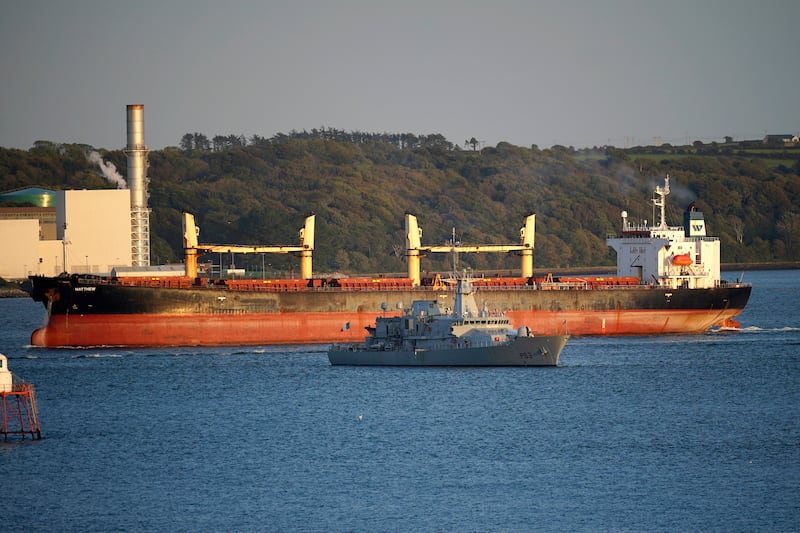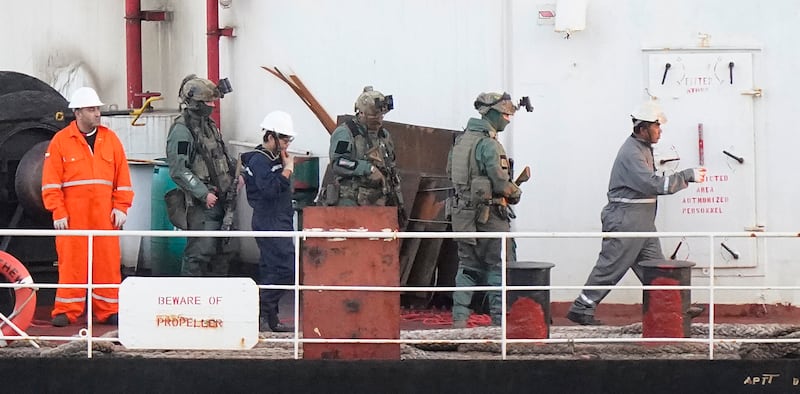A “murderous” South American Cartel, working with Irish and European organised crime groups, was behind the attempt to smuggle 2.2 tonnes of cocaine through Irish waters, gardaí have said.
In a briefing on Wednesday, Garda, Naval and Revenue officials laid out the details of the most complex anti-drugs operation ever undertaken in Ireland which led to the seizure of an estimated €157 million worth of cocaine, the largest consignment ever uncovered in this country.
The operation, which is still ongoing, involved the deployment of special forces from a helicopter on to a moving ship, the Panamanian registered MV Matthew, which had earlier attempted to evade an Irish naval ship.
As well as various Irish agencies operating under the umbrella of a Joint Task Force, the operation involved the US Drug Enforcement Agency (DEA), the UK National Crime Agency (NCA) and French police. It was co-ordinated internationally by the Maritime Analysis and Operations Centre-Narcotics (Maoc-N) based in Portugal.
Revenue Commissioner and Director General of Customs Gerry Harrahill praised the “exhausted” teams involved in the operation while Assistant Garda Commissioner Justin Kelly said he “cannot overemphasise the significance of this operation or the impact it will have on criminal groups.”
He said the cocaine came from “one of the murderous cartels” operating in South America. It involved an Irish organised crime group and elements of groups based on the Continent, although Mr Kelly declined to say which ones.
“There’s a number of organised groups who come together on a load that size.”
He said the seizure is a “huge hit” to the criminal gangs. “As you can imagine, there is significant outlay in terms of getting an operation like this up and running. Obviously, there’s the purchase of the vessels, there’s the payment of people involved and the corrupting of officials across the globe to become involved in something like this.”
Mr Kelly said the message he wants to go out is that “Ireland is not an easy place to import drugs into.”
Initial estimates put the value of the cocaine at €157 million, although this may increase or decease once purity tests are completed. If it had reached the street, the value could have increased five-fold or more, depending on how much criminal gangs diluted it.
[ Cork drugs haul: What do we know about the gang and the ship they used?Opens in new window ]
A portion of the drugs were destined for Ireland with the rest for “other markets”, Mr Kelly said.
It remains possible more cocaine may be recovered from a fishing trawler stranded off the Wexford Coast which gardaí believe was used to ferry drugs from the MV Matthew to the shore.
The fishing vessel, named the Castlemore, remains stranded on a sandbank about 12 miles out to sea and is in danger of breaking up. Two men were rescued from it by a Coastguard helicopter on Sunday and were later arrested.

The weather conditions mean authorities have not been able to land on and search the smaller vessel. Once gardaí can get aboard, it will be declared a crime scene, Mr Kelly said.
It is not clear if any cocaine is aboard or if some of the drug was thrown overboard before the men were rescued.
A third man, believed to be the captain of the MV Matthew, is also in custody. He was arrested yesterday after being medically evacuated from the ship on Monday, before the boarding operation.
Mr Kelly said more arrests may follow. The MV Matthew had a crew of roughly 25, all of whom will be interviewed by gardaí. Arrests and searches may also follow in other countries.
Irish authorities became involved in the operation on September 22nd when, acting on international intelligence, a Joint Task Force was established involving Revenue, the Garda and the Defence Forces.
As part of this Irish Naval Service personnel were designated customs officials under law in preparation for any boarding. It was the first time the legislation, which was introduced in 2015, was used.
The MV Matthew was tracked entering Irish waters and shadowed by the LÉ William Butler Yeats and an Air Corps PC-12 aircraft.
It was destined for Belfast but reported engine trouble and plotted a route to Cork for repairs. It was then intercepted by the LÉ William Butler Yeats and instructed to take a certain course by a Naval captain.
The ship attempted to evade its pursuers, prompting the Naval Service to fire two shots across its bow from its 76mm gun. This was “to compel the vessel to follow the instruction of the ship’s captain,” Naval Service Commander Tony Geraghty said.
Personnel from the Army Ranger Wing (ARW), the Defence Forces special forces Unit, then fast roped on to the deck of the ship as it attempted to manoeuvre away.
They secured the ship and did not face armed resistance. Naval Service “rummaging teams” then boarded the vessel to locate and secure the drugs.
“It was an extremely complex day from a military perspective”, said Cmdr Geraghty. “The Naval Service, the Air Corps and the Army Ranger Wing rehearse for this type of operation.”
The Air Corps pilots are “really top notch” and the ARW “are really high achieving guys who are as good as anyone in the world,” he said.

After the boarding the ship was escorted into Cork Harbour for further search operations. The drugs have now been removed from the ship into secure storage.
Mr Kelly declined to go into detail on several aspects of the operation, including the role played by the Castlemore, except to say it was a “vessel of interest” from the day the Taskforce was stood up on September 22nd.
The fishing vessel left Castletownbere in West Cork that day just hours after it was purchased by an unknown buyer before becoming grounded off the Wexford coast on Sunday night. Witnesses reported saying the buyers did not seem to be experienced seafarers.
Officials also declined to say how the drugs were hidden on the MV Matthew, a 189-metre-long bulk carrier valued at €9.5 million, or if there was any attempt by the crew to dispose of the cocaine before the boarding.
Mr Kelly said cocaine production has increased in South America for “a number of geopolitical reasons”, leading to a glut in the market.
Europe is now the world’s biggest consumer of the drug and it is inevitable organised crime groups will try to exploit that, he said.
“It is inevitable we will see more large shipments,” Mr Kelly said. “This is what is being seen in other ports, particularly Antwerp and Rotterdam.”
Asked if Ireland is becoming a gateway for cocaine smuggling into Europe, Mr Kelly said gangs will look for weakness anywhere they can.
“I wouldn’t agree that Ireland is seen as a weaker entry point. We’re seeing huge seizures all across the Continent.”











